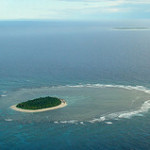 A recent study linking deep-sea biodiversity to ecosystem processes recognized that 1) the deep-sea supports the largest biomass of living things on the planet and 2) the deep-sea represents the most important ecosystem for carbon, nitrogen, and phosphorous cycling. The chosen indicator species for the study was the nematode worm.
A recent study linking deep-sea biodiversity to ecosystem processes recognized that 1) the deep-sea supports the largest biomass of living things on the planet and 2) the deep-sea represents the most important ecosystem for carbon, nitrogen, and phosphorous cycling. The chosen indicator species for the study was the nematode worm.
Nematodes apparently account for 90% of all life at the bottom of the sea. I am unsure whether this is given in terms of species richness or biomass, but either way, it’s an image problem. Just kidding, of course. The new study is published in the January 8 issue of the journal Current Biology.
Dr. Roberto Danovaro of Polytechnic University of Marche, Italy led the research team in a study of 116 sites. The results indicate an exponential increase in ecosystem processes and efficiency with increased nematode diversity. That means a small increase (or decrease) in the number of species results in a large increase (or decrease) in the rate and the efficiency of nutrient cycles. This is in contrast to terrestrial findings, which have generally shown a linear relationship between diversity and ecosystem function, such that a small increase in species would yield a small increase in efficiency.
More on the story at ScienceDaily. Tell me what you think of their headline.
Photo: Trissonchulus sp., from Dr. Tim Ferrero, The Natural History Museum, London, UK. Published in MEPS.






A recent study linking deep-sea biodiversity to ecosystem processes recognized that 1) the deep-sea supports the largest biomass of living things on the planet and 2) the deep-sea represents the most important ecosystem for carbon, nitrogen, and phosphorous cycling. The chosen indicator species for the study was the nematode worm.
This is pretty amazing. I know for years, I and everyone I knew thought of the deep part of the deep blue sea as a big empty space. Now with people finding new species every week and also discovering the huge quantity of life down there, it turns out to be a very interesting place!
Dave Briggs :~)
“Deep-sea Species’ Loss Could Lead to Ocean’s Collapse, Study Suggests”
Well, life wouldn’t be the same without a bit of healthy apocalyptic doom and gloom mongering, now, would it? So I suppose the papers chose the most controversial aspect of the report in order to get their readers to read anything of it at all? A headline that said something like “Scientists say we must look after all the bits of the Ocean we can’t see” wouldn’t have quite the same ring. Mind you, maybe they have got to the heart of it and are right . . . a-a-a-r-g-h!
Ocean’s collapse? I just can’t picture the physics of it.
ScienceDaily is stretching the point, in my opinion.
Nematodes apparently account for 90% of all life at the bottom of the sea. I am unsure whether this is given in terms of species richness or biomass
This could only be in biomass, not in raw counts of individuals or species richness (the latter being a pretty meaningless metric when applied across diverse groups of organisms such as metazoans and bacteria). Even in biomass, I’m skeptical of that estimate. Perhaps this refers to eukaryotic or metazoan biomass.
Definitely metazoan biomass and abundance. Potentially for diversity.
I am studying nematodes from deep sea. Yes this is a satisfactory statement that nematodes contributing 80 to 90% of all life in the deep ocean.I am predicting nematodes are playing a major role in ocean productivity.
I’ve similar statements from other meiofauna biologists. But we should make the distinction between ALL life and all metazoan life. My labmate next to me argues with me all the time that fungi in the deep sea are the most dominant sequence in his sediment cores.